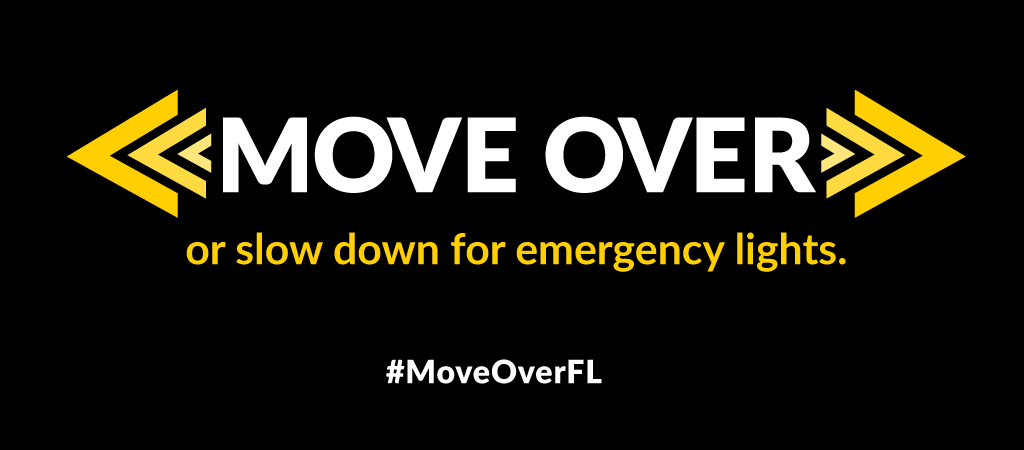When You See Flashing Lights, Move Over, Florida, It’s The Law
~ FLHSMV emphasizes the critical message of giving first responders and utility workers room to work ~
TALLAHASSEE, Fla. – January is Move Over month and the Florida Department of Highway Safety and Motor Vehicles (FLHSMV) urges all motorists to move over for emergency and service vehicles stopped along the roadway. Preliminarily in 2019, there were 182 crashes and over 20,000 citations issued for motorists failing to move over. FLHSMV and the Florida Highway Patrol (FHP) are partnering with the Florida Department of Transportation, Florida Police Chiefs Association, Florida Sheriffs Association and AAA – The Auto Club Group to ensure all law enforcement, first responders, service and utility workers and Road Rangers Arrive Alive in 2020.
“When a crash occurs, law enforcement and first responders are there. When a disabled vehicle needs assistance, Road Rangers or tow truck drivers are there. When power lines need repairs, utility and service workers are there,” said FLHSMV Executive Director, Terry L. Rhodes. “The Move Over Law is in place to protect those who serve all of us on the roadways, giving them a safe space to do their jobs. Move Over, Florida, and help ensure that these public servants come home safely each day.”
The Move Over Law was added to section 316.126, Florida Statutes, in 2002. The statute, which was originally introduced in 1971, requires motorists to move or yield right-of-way to emergency vehicles and in 2014, utility and sanitation vehicles were added to the Move Over Law. The Move Over Law states that drivers must move over as soon as it is safe to do so for any authorized law enforcement, emergency or service vehicles displaying any visible signals while stopped on the roadside, including Road Rangers, sanitation vehicles and tow trucks.
“The simple act of moving over gives law enforcement, emergency first responders and other service vehicles adequate space to do their jobs and can greatly increase safety on Florida’s roadways,” said Colonel Gene Spaulding, Director of the Florida Highway Patrol. “The Move Over Law was enacted to help protect public service professionals while they protect Florida’s motorists in one of the most dangerous environments: the side of the roadway.”
When motorists cannot vacate the lane closest to the emergency or service vehicle, they must slow to a speed that is 20 miles per hour less than the posted speed limit. Failure to yield or move over puts law enforcement officers, emergency first responders and public service workers in danger while they are on the job protecting and serving the citizens and visitors of Florida.
“The Move Over Law is a necessary step to ensuring that we protect those individuals who help our most vulnerable,” said Florida Department of Transportation Secretary Kevin J. Thibault, P.E. “The next time you see a member of law enforcement, first responder, or FDOT Road Ranger on the roadside, do your part and move over.”
“While protecting the motoring public, deputy sheriffs and other first responders are in harm’s way daily during traffic stops and traffic crash investigations. Please follow the law and do your part to protect those who protect you on Florida’s roads by “moving over” to another lane,” stated Sheriff Bob Gualtieri, President of the Florida Sheriffs Association.
“Every year far too many law enforcement officers, as well as emergency, sanitation, wrecker and utility service workers are needlessly injured or killed along Florida’s roadways,” said Chief Kenneth Albano, Temple Terrace Police Department and President of the Florida Police Chiefs Association. “Floridians can help keep themselves and our officers, first responders and other public service professionals safe by staying alert, vacating the lane closest to any of the aforementioned vehicles, traveling in the same direction, that are actively displaying any visual signals and when all else fails, simply slowing down to at least 20 mph less than the posted speed limit as you pass by.”
“The roadside is one of the most dangerous places on Earth to work,” said Matt Nasworthy, Florida Public Affairs Director, AAA – The Auto Club Group. “Please protect those that protect us, by giving them more room or slowing down when that’s not possible.”
To comply with the Move Over Law drivers must:
Multi-Lane Roadway:
- Vacate the lane closest to the stationary emergency vehicle, sanitation vehicle, utility service vehicle, Road Ranger or wrecker and always signal the intention to change lanes.
- Slow down to a speed of 20 mph below the posted speed limit if a driver cannot move over safely.
- Be prepared to allow those who are attempting to move over into the next lane.
Two-Lane Roadway:
- Slow down to a speed of 20 mph below the posted speed limit.
- Travel at 5 mph if the speed limit is 20 mph or less.
The public is encouraged to report aggressive drivers by dialing *FHP (*347). For more information on the Move Over Law, visit: https://www.flhsmv.gov/safety-center/driving-safety/move-over/.
The Florida Department of Highway Safety and Motor Vehicles (FLHSMV) provides highway safety and security through excellence in service, education and enforcement. FL is leading the way to A Safer Florida through the efficient and professional execution of its core mission: the issuance of driver licenses, vehicle tags and titles and operation of the Florida Highway Patrol. To learn more about FLHSMV and the services offered, visit https://www.flhsmv.gov, follow us on Twitter @FLHSMV, find us on Facebook or follow us on Instagram.


Dave Kerner, Executive Director